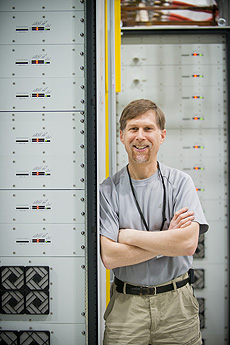One minute with Dave Peterson, electrical engineer
 |
| Dave Peterson works on high-level radio-frequency systems for the Accelerator Division. Photo: Reidar Hahn |
How long have you been at Fermilab?
I'm coming up on 31 years.
What brought you to Fermilab?
I was working in electron beam lithography at IBM in upstate New York, but my wife and I are both from the Chicago area and we wanted to get back here. There was an opening at Fermilab and I applied. It was the early days of the antiproton source construction, so they were looking for an electrical engineer.
What does your typical workday look like?
Every day is a bit different. I do design work for new projects. I also go out to the service buildings and other areas of activity to do upgrades to existing equipment or plan for new installations. There's also the occasional meeting and other matters that go along with being an engineer.
What would you consider the most exciting part of your job?
I like the challenge of figuring out how to do things that are new. Of course, having been here 30 years, I think it's interesting to see how different electronic systems decline in old age, and I try to diagnose what we can do better to make them more reliable.
You've been featured before in Fermilab Today for your handmade snowplow. What inspired it?
There's this little stretch through the forest preserve on the seven-mile bike trip between my home and Fermilab that doesn't get plowed like the streets do. There's no good detour, and I didn't want to get crushed on the busy streets, so at first I went out with a shovel and walked it for two hours. Then I thought that if I could take something along with my bike, I could ride with it. I eventually ended up with three plows: two different ones I pull behind the bike — one with wheels and a lighter-weight one that just scrapes along — and a walking push plow.
What is something people might not know about you?
I've had assorted misadventures on the bike trail. Chipmunks running at my wheels, deer leaping in front of me and, in the spring, aggressive red-winged blackbirds diving from above. I got hit on the head by an angry goose one time down by the Fox River. All good reasons to wear a helmet.
—Diana Kwon
If there's an employee, user or contractor you'd like to see profiled in Fermilab Today, please email today@fnal.gov.
|